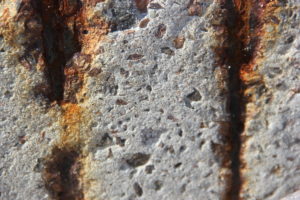One way to make structures more sustainable is to make them durable. You can design your concrete for durability. You can also design and detail your concrete structure for durability. This two-pronged approach results in durable–and sustainable–concrete structures.

Control cracking
No matter how good the concrete is, if it’s full of cracks it won’t be durable. The key to durable concrete structures is to limit crack width.
Reinforced concrete cracks. In fact, the reinforcement doesn’t even start to do its job until the concrete cracks. But some cracks are worse than others. Cracks open to the top surface of a roof, bridge deck, or parking deck are worse than those that open to the bottom surface. For this reason a simply-supported beam or slab is easier to maintain than one that is continuous over multiple supports. Over the supports, the slab will have cracks open to the top surface, where water and salts can easily enter, but not easily drain out.
The higher the tensile stress, the likelier the concrete is to crack. Prestressed concrete, which is initially compressed by the use of internal steel strand or tendons, has lower tensile stresses. The structural engineer can also design the member sections so that the tensile stress is less.
For crack control, small, closely spaced reinforcing bars are better than widely spaced large ones. The spacing of the reinforcing bars must be wide enough for good consolidation of the concrete, however. Fiber reinforcement is the ultimate in small, closely-spaced reinforcement.
Concrete shrinks on drying. It also contracts on cooling and expands on heating. Support conditions that limit shrinkage or contraction lead to tensile stress that may cause cracking. Proper joint design and spacing can reduce these stresses.
Keep water out
Any surface that is exposed to water should be designed to let the water drain off. Water sitting on the surface will eventually migrate into the concrete. Water on surfaces can also be hazardous to users, as it promotes slipping.
The thickness of the concrete cover over the steel directly relates to how long chloride ions will take to migrate from the surface to the steel.
The concrete can also be designed for volume stability. If it will experience large changes in temperature it should have a low coefficient of thermal expansion. The engineer who wants to design durable concrete structures must understand how the concrete will behave.
